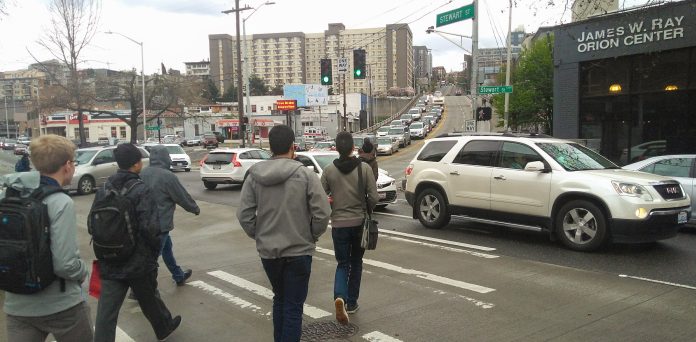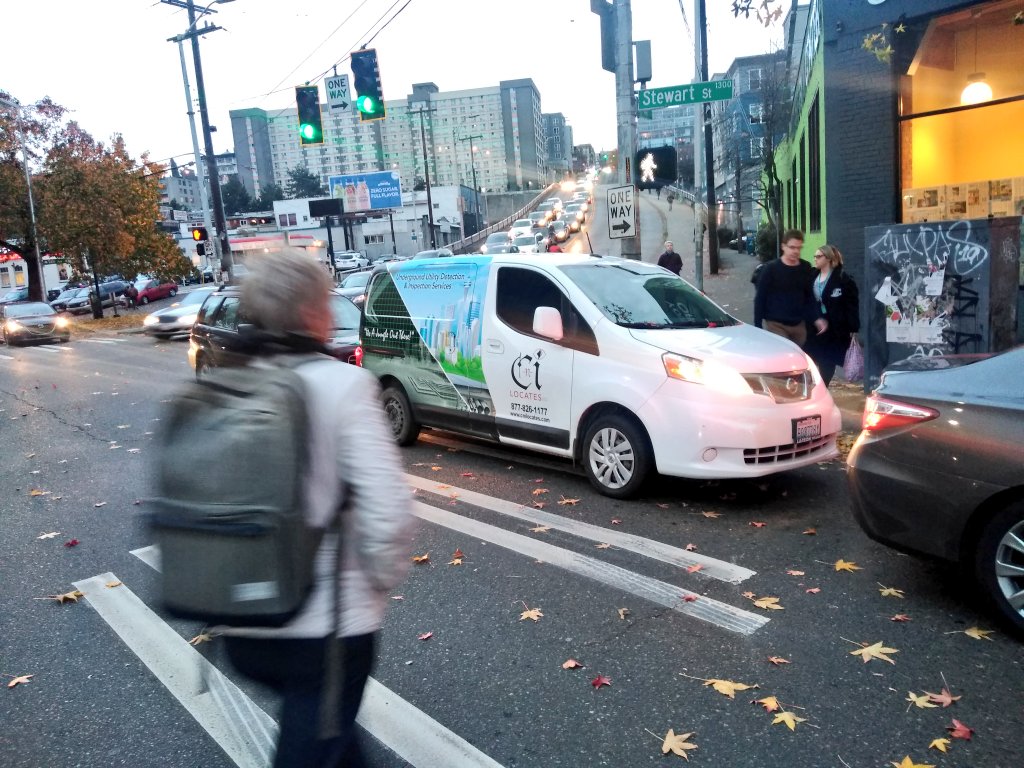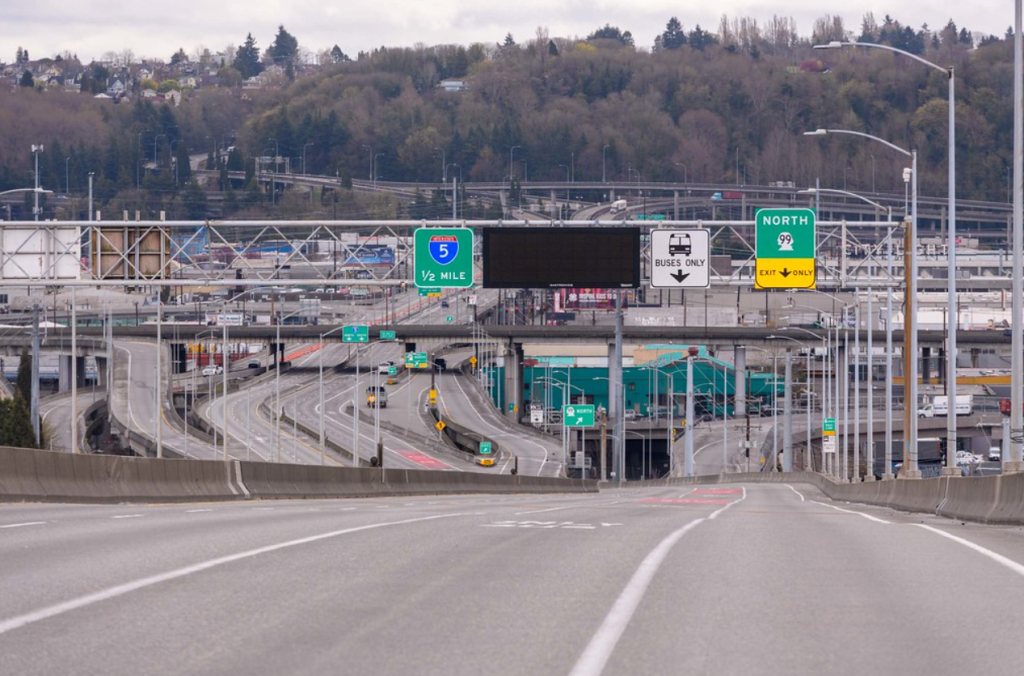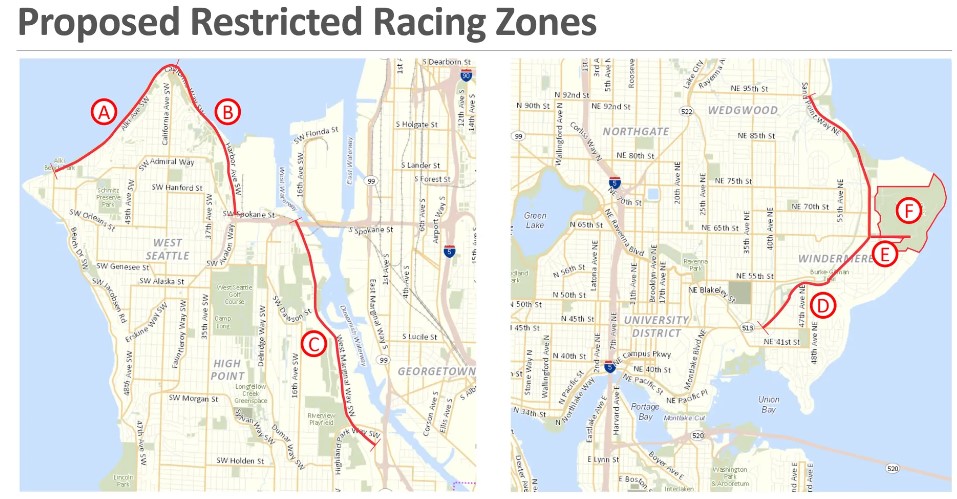
The Seattle Department of Transportation (SDOT) has announced plans to install automatic traffic enforcement cameras at three locations to enforce dedicated transit lanes and intersection blocking, taking further advantage of a pilot program authorized by the state legislature in 2020. The new cameras all target locations with long-standing complaints of low compliance with traffic laws and look poised to have a positive impact on mobility for transit riders and pedestrians alike.
The new intersection cameras, ticketing drivers blocking either a marked crosswalk or the “box” in the middle of an intersection, will be installed at two infamously congested intersections that function as extended I-5 ramps in north downtown: Stewart Street and Denny Way, and Howell Street and Boren Avenue. “The locations were selected due to the large volume of pedestrians present combined with a high rate of observed violations by drivers,” the department noted in its announcement.

SDOT will also install a camera enforcing the dedicated transit lane on the West Seattle Bridge, just west of State Route 99. The bridge’s bus lane is one of the most heavily-used transit corridors in the city, and an enforcement camera here has been long-requested by West Seattle residents.

These three additional cameras will bring the total number of active cameras under the state pilot program to 11, with one location (Fifth Avenue and Olive Way) acting as both a transit lane and a block-the-box camera. Originally set to expire this summer, authorization for these two types of automatic traffic cameras was extended until mid-2025, with a preliminary report due to the state legislature by next summer.
“The new cameras will allow the city to collect a larger data set for a more robust analysis of the impact and effectiveness of these types of automated enforcement programs,” SDOT noted.

SDOT is expecting to install the new cameras in early September, followed shortly thereafter by activation and a 30-day period where nothing but warnings are issued, no matter how many times a driver activates a camera. After that, every driver is issued a warning followed by a $75 citation.
Initial data on the first round of cameras obtained by The Urbanist late last year showed a high number of issued tickets for the transit lane cameras, but a much higher warning-to-infraction ratio for the active block-the-box cameras. That data suggested that the cameras were having their intended effect of impacting future driver behavior, though the relatively small number of cameras in the city didn’t provide a huge sample size and more data may very well show more repeat offenders.
All three new cameras have the potential to improve bus travel times at a time when King County Metro faces declining on-time performance as more commuters return to the city’s roads. In particular, the Route 8, which saw the number of late buses skyrocket as Amazon implemented new return-to-work policies late this spring, will benefit from Denny Way and Stewart Street clear of blocking vehicles. Currently, the Route 8 has its own eastbound lane between Fairview Avenue and Stewart Street, but often spends another light cycle or two just trying to get onto the I-5 overpass into Capitol Hill due to drivers blocking the intersection.
After overhead costs are accounted for, 50% of the funds from Seattle’s specialized enforcement cameras are allocated to the state transportation commission’s Cooper Jones Active Transportation Safety Council. After months of ad-hoc decision-making around how to utilize this new source of funding, in July the Council adopted an official framework that aligns the funding source with its charter: the funds will be directed toward data collection, staffing, or other direct activities that support the body’s recommendations to the state legislature when it comes to improving safety for people who walk or roll. For example, the Council has been working on a study looking at how to recommend improvements to pedestrian-scale lighting statewide to improve safety.
The remaining 50% is directed toward “improvements to transportation that support equitable access and mobility for persons with disabilities,” per state law. SDOT has been utilizing those funds so far for Accessible Pedestrian Signal (APS) installation, which helps people with low vision know when it’s safe to cross the street. As of 2020, only around a quarter of Seattle’s pedestrian signals were equipped with APS, though that number is set to significantly increase in future years thanks to this dedicated funding source as well as a major federal safety grant.
These new automatic cameras come just as the Seattle city council is contemplating just how camera enforcement might be expanded citywide in future years, with a recent update to the council’s transportation committee detailing how a deadline to double the number of school zone speed cameras before the start of the 2024-2025 school year will almost certainly be pushed into early 2025 at the earliest.

Cameras enforcing “street racing zones” near hospitals or parks, along school walk routes, and at chronically unsafe intersections are also now set to be allowed under Seattle’s city code thanks to recently approved legislation. That said, how exactly those are rolled out is going to depend a lot on future direction from the city council as long implementation times at SDOT and limited staffing at the Seattle Police Department to process the fines (as required by state law) remain constraints.
The three new cameras set to go in this fall could further strengthen support behind using camera enforcement to reduce problematic behavior without direct police interaction, even if the city merely continues expanding cameras on a case-by-case basis. What’s clear is that automatic camera enforcement in Seattle is here to stay, even if the state pilot for these specific types of cameras does ultimately expire.
Ryan Packer has been writing for The Urbanist since 2015, and currently reports full-time as Contributing Editor. Their beats are transportation, land use, public space, traffic safety, and obscure community meetings. Packer has also reported for other regional outlets including BikePortland, Seattle Met, and PubliCola. They live in the Capitol Hill neighborhood of Seattle.

